A Novel WPT System Based on Dual Transmitters and Dual Receivers for High Power Applications: Analysis, Design and Implementation
Abstract
:1. Introduction
- (1)
- A novel WPT system with high reliability based on dual overlapped transmitters and dual receivers are proposed to enhance the transmitted power, which is a potential method for high power applications.
- (2)
- The effects of same-side couplings are analyzed by the equivalent circuit, and decoupling transformers are adopted to eliminate the effects of same-side couplings. As a result, the WPT system can maintain a constant resonant frequency.
- (3)
- The output voltage in the secondary side can be regulated at its designed value with a fast response performance by the designed controller.
2. Proposed Magnetic Coupling Structure
3. Analysis of the Proposed WPT System
3.1. Circuit Modeling
3.2. Characteristic Analysis with Decoupling Transformers
3.3. Conduction Losses Estimation
3.4. Control Diagram
4. Experimental Verification
4.1. Prototype System
4.2. Experimental Results
5. Discussion and Comparison with Traditional WPT Systems
6. Conclusions
Acknowledgments
Author Contributions
Conflicts of Interest
References
- Graham, D.J.; Neasham, J.A.; Sharif, B.S. Investigation of methods for data communication and power delivery through metals. IEEE Trans. Ind. Electron. 2011, 58, 4972–4980. [Google Scholar] [CrossRef]
- Moorey, C.; Holderbaum, W.; Potter, B. Investigation of High-Efficiency Wireless Power Transfer Criteria of Resonantly-Coupled Loops and Dipoles through Analysis of the Figure of Merit. Energies 2015, 8, 11342–11362. [Google Scholar] [CrossRef]
- Amini, M.R.; Farzanehfard, H. Three-phase soft-switching inverter with minimum components. IEEE Trans. Ind. Electron. 2011, 58, 2258–2264. [Google Scholar] [CrossRef]
- Li, Y.L.; Sun, Y.; Dai, X. μ-Synthesis for Frequency Uncertainty of the ICPT System. IEEE Trans. Ind. Electron. 2013, 60, 291–300. [Google Scholar] [CrossRef]
- Joun, G.B.; Cho, B.H. An energy transmission system for an artificial heart using leakage inductance compensation of transcutaneous transformer. IEEE Trans. Power Electron. 1998, 13, 1013–1022. [Google Scholar] [CrossRef]
- Si, P.; Hu, A.P.; Malpas, S. A frequency control method for regulating wireless power to implantable devices. IEEE Trans. Biomed. Circuits Syst. 2008, 2, 22–29. [Google Scholar] [CrossRef] [PubMed]
- Klontz, K.W.; Divan, D.M.; Novotny, D.W. Contactless power delivery system for mining applications. IEEE Trans. Ind. Appl. 1995, 31, 27–35. [Google Scholar] [CrossRef]
- Kuipers, J.; Bruning, H.; Bakker, S. Near field resonant inductive coupling to power electronic devices dispersed in water. Sens. Actuators A Phys. 2012, 178, 217–222. [Google Scholar] [CrossRef]
- Hasanzadeh, S.; Vaez-Zadeh, S.; Isfahani, A.H. Optimization of a contactless power transfer system for electric vehicles. IEEE Trans. Veh. Technol. 2012, 61, 3566–3573. [Google Scholar] [CrossRef]
- Zhong, W.X.; Zhang, C.; Liu, X. A methodology for making a three-coil wireless power transfer system more energy efficient than a two-coil counterpart for extended transfer distance. IEEE Trans. Power Electron. 2015, 30, 933–942. [Google Scholar] [CrossRef]
- Smeets, J.P.C.; Overboom, T.T.; Jansen, J.W. Comparison of position-independent contactless energy transfer systems. IEEE Trans. Power Electron. 2013, 28, 2059–2067. [Google Scholar] [CrossRef]
- Elliott, G.A.J.; Raabe, S.; Covic, G.A. Multiphase pickups for large lateral tolerance contactless power-transfer systems. IEEE Trans. Ind. Electron. 2010, 57, 1590–1598. [Google Scholar] [CrossRef]
- Huh, J.; Lee, S.W.; Lee, W.Y. Narrow-width inductive power transfer system for online electrical vehicles. IEEE Trans. Power Electron. 2011, 26, 3666–3679. [Google Scholar] [CrossRef]
- Kim, J.; Lee, B.; Lee, J.; Lee, S.; Park, C.; Jung, S.; Lee, S.; Yi, K.; Baek, J. Development of 1 MW Inductive Power Transfer System for a High Speed Train. IEEE Trans. Ind. Electron. 2015, 62, 6242–6250. [Google Scholar] [CrossRef]
- Li, Y.; Mai, R.; Yang, M.; He, Z. Cascaded Multi-Level Inverter Based IPT Systems for High Power Applications. J. Power Electron. 2015, 15, 1508–1516. [Google Scholar] [CrossRef]
- Hao, H.; Covic, G.A.; Boys, J.T. A parallel topology for inductive power transfer power supplies. IEEE Trans. Power Electron. 2014, 29, 1140–1151. [Google Scholar] [CrossRef]
- Li, Y.; Mai, R.K.; Lu, L.W.; He, Z.Y. Active and Reactive Currents Decomposition based Control of Angle and Magnitude of Current for a Parallel Multi-Inverter IPT System. IEEE Trans. Power Electron. 2017, 32, 1602–1614. [Google Scholar] [CrossRef]
- Johari, R.; Krogmeier, J.V.; Love, D.J. Analysis and practical considerations in implementing multiple transmitters for wireless power transfer via coupled magnetic resonance. IEEE Trans. Ind. Electron. 2014, 61, 1774–1783. [Google Scholar] [CrossRef]
- Ahn, D.; Hong, S. Effect of coupling between multiple transmitters or multiple receivers on wireless power transfer. IEEE Trans. Ind. Electron. 2013, 60, 2602–2613. [Google Scholar] [CrossRef]
- Li, Y.; Mai, R.; Lu, L.; He, Z. A Novel IPT System Based on Dual Coupled Primary Tracks for High Power Applications. J. Power Electron. 2016, 16, 111–120. [Google Scholar] [CrossRef]
- Yoon, I.J.; Ling, H. Investigation of Near-Field Wireless Power Transfer under Multiple Transmitters. IEEE Antennas Wirel. Propag. Lett. 2011, 10, 662–665. [Google Scholar] [CrossRef]
- Nguyen, C.M.; Kota, P.K.; Nguyen, M.Q.; Dubey, S.; Rao, S.; Mays, J.; Chiao, J.C. Wireless Power Transfer for Autonomous Wearable Neurotransmitter Sensors. Sensors 2015, 15, 24553–24572. [Google Scholar] [CrossRef] [PubMed]
- Rajagopal, S.; Khan, F. Multiple Receiver Support for Magnetic Resonance Based Wireless Charging. In Proceedings of the IEEE International Conference on Communications Workshops, Tokyo, Japan, 5–9 June 2011; pp. 1–5.
- Cannon, B.L.; Hoburg, J.F.; Stancil, D.D.; Goldstein, S.C. Magnetic Resonant Coupling as a Potential Means for Wireless Power Transfer to Multiple Small Receivers. IEEE Trans. Power Electron. 2009, 24, 1819–1825. [Google Scholar] [CrossRef]
- Imura, T.; Hori, Y. Optimization using transmitting circuit of multiple receiving antennas for wireless power transfer via magnetic resonance coupling. In Proceedings of the Telecommunications Energy Conference, Amsterdam, The Netherlands, 9–13 October 2011; Volume 47, pp. 1–4.
- Nguyen, H.; Agbinya, J.I.; Devlin, J. FPGA-based implementation of multiple modes in near field inductive communication using frequency splitting and MIMO configuration. IEEE Trans. Circuits Syst. I Regul. Pap. 2015, 62, 302–310. [Google Scholar] [CrossRef]
- Madawala, U.K.; Thrimawithana, D.J. Modular-based inductive power transfer system for high-power applications. IET Power Electron. 2012, 5, 1119–1126. [Google Scholar] [CrossRef]
- Zhen, N.L.; Casanova, J.J.; Lin, J. A Loosely Coupled Planar Wireless Power Transfer System Supporting Multiple Receivers. IEEE Trans. Ind. Electron. 2009, 56, 3060–3068. [Google Scholar]
- Li, X.; Zhang, H.; Peng, F.; Li, Y.; Yang, T.; Wang, B.; Fang, D. A Wireless Magnetic Resonance Energy Transfer System for Micro Implantable Medical Sensors. Sensors 2012, 12, 10292–10308. [Google Scholar] [CrossRef] [PubMed]
- Kim, J.W.; Son, H.C.; Kim, D.H.; Yang, J.R.; Kim, K.H.; Lee, K.M.; Park, Y.J. Wireless power transfer for free positioning using compact planar multiple self-resonators. In Proceedings of the Microwave Workshop Series on Innovative Wireless Power Transmission: Technologies, Systems, and Applications, Tokyo, Japan, 10–11 May 2012; pp. 127–130.
- Kim, J.; Son, H.C.; Kim, D.H.; Park, Y.J. Optimal design of a wireless power transfer system with multiple self-resonators for an LED TV. IEEE Trans. Consum. Electron. 2012, 58, 775–780. [Google Scholar] [CrossRef]
- Song, Y.; Madawala, U.K.; Hu, A.P. Cross coupling effects of poly-phase bi-directional inductive power transfer systems used for EV charging. In Proceedings of the Future Energy Electronics Conference (IFEEC), Taipei, Taiwan, 1–4 November 2015; pp. 1–7.
- Kissin, M.L.G.; Boys, J.T.; Covic, G.A. Interphase mutual inductance in polyphase inductive power transfer systems. IEEE Trans. Ind. Electron. 2009, 56, 2393–2400. [Google Scholar] [CrossRef]
- Choi, S.Y.; Jeong, S.Y.; Lee, E.S.; Gu, B.W.; Lee, S.W.; Rim, C.T. Generalized models on self-decoupled dual pick-up coils for large lateral tolerance. IEEE Trans. Power Electron. 2015, 30, 6434–6445. [Google Scholar] [CrossRef]
- Nordic Semiconductor. nRF24L01+ Datasheet. 2013. Available online: http://www.nordicsemi.com/eng/Products/2.4GHz-RF/nRF24L01P (accessed on 14 October 2016).
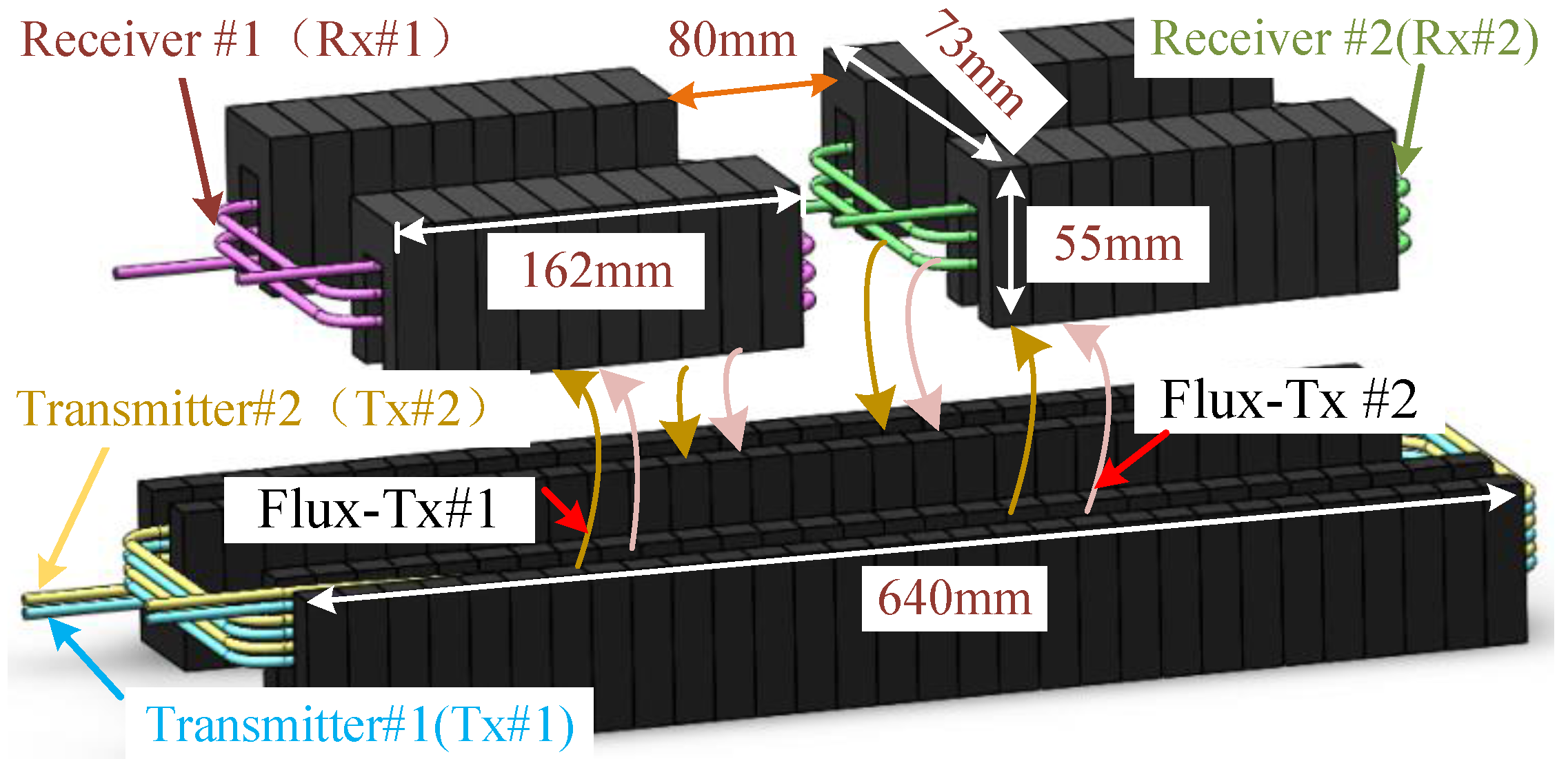


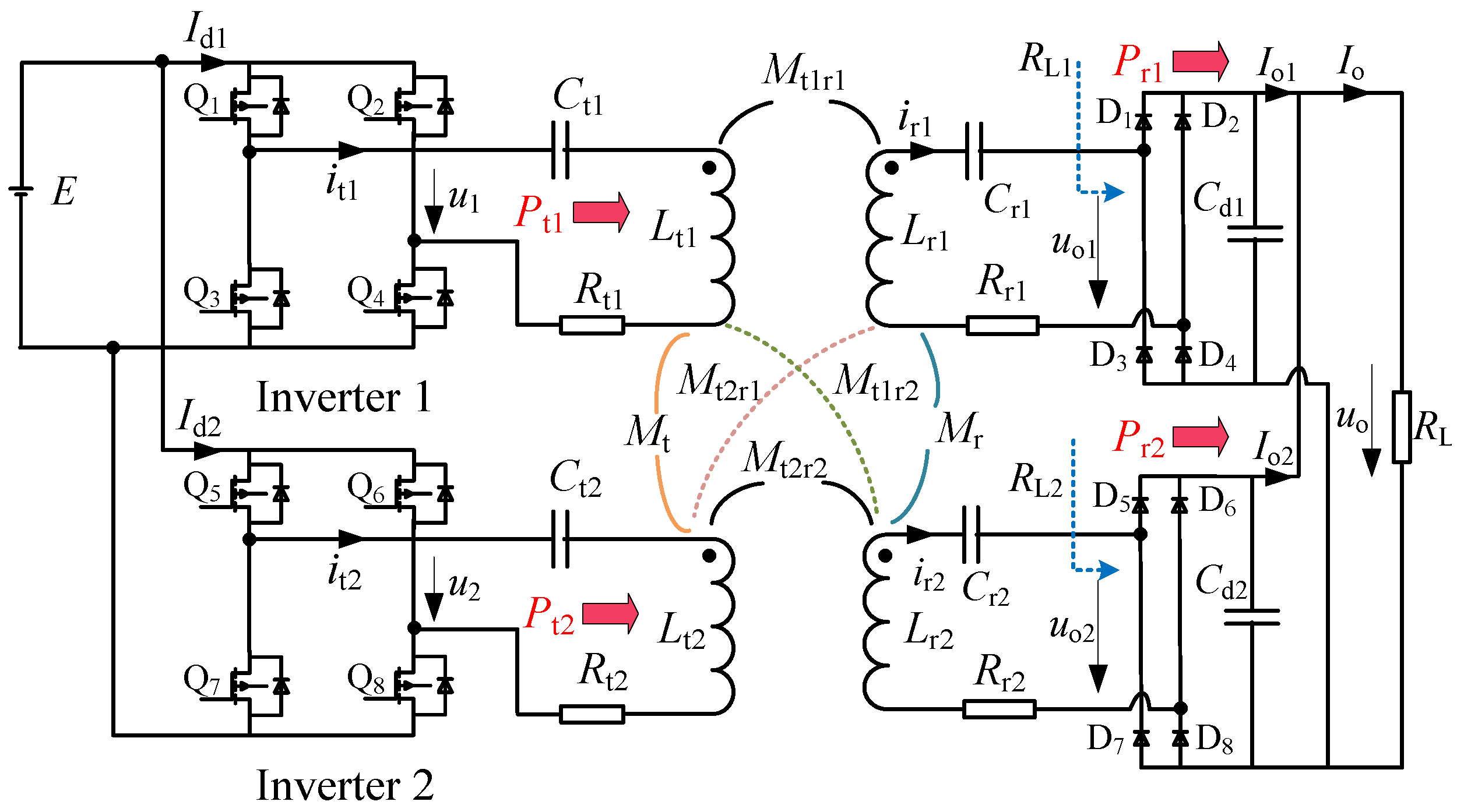
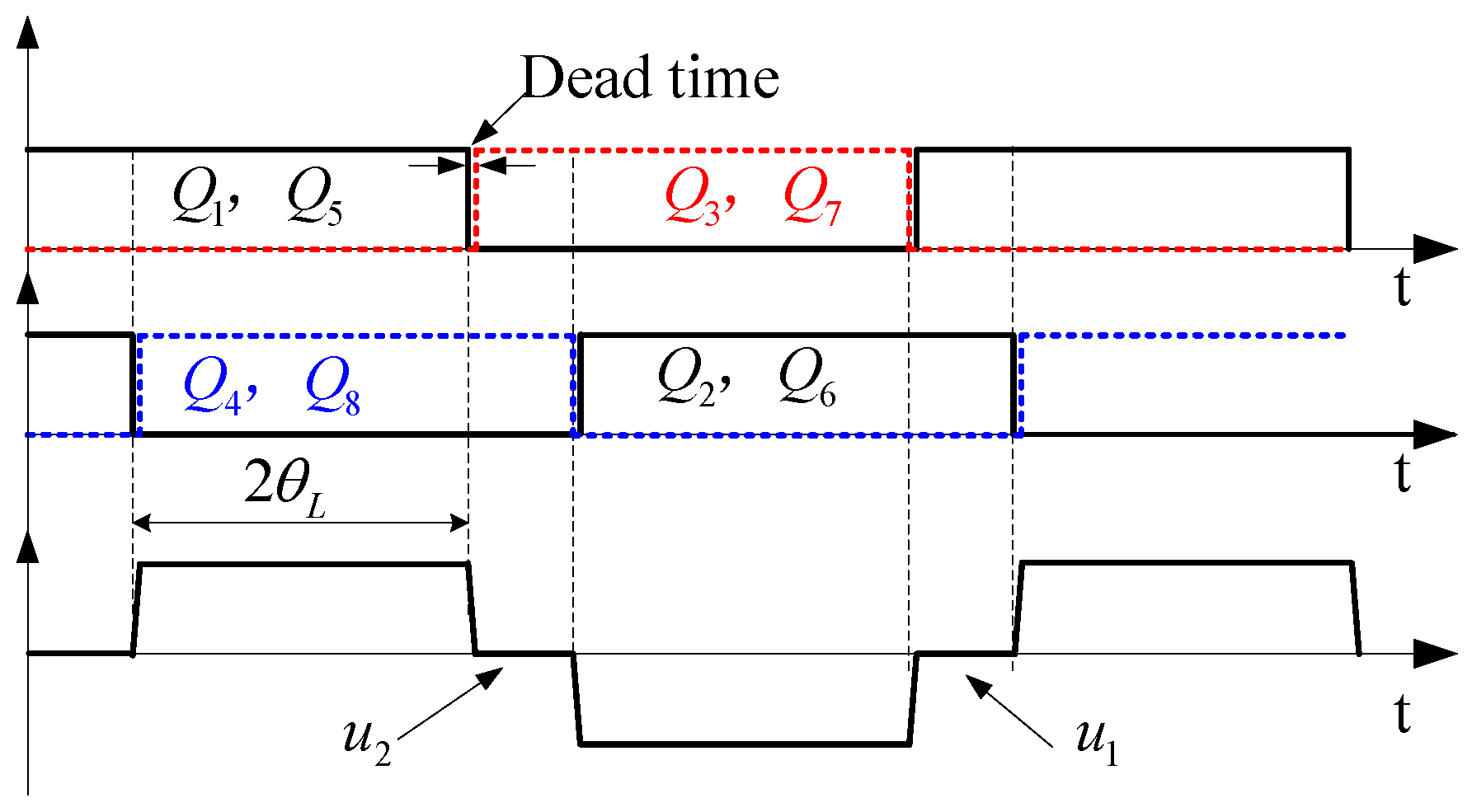
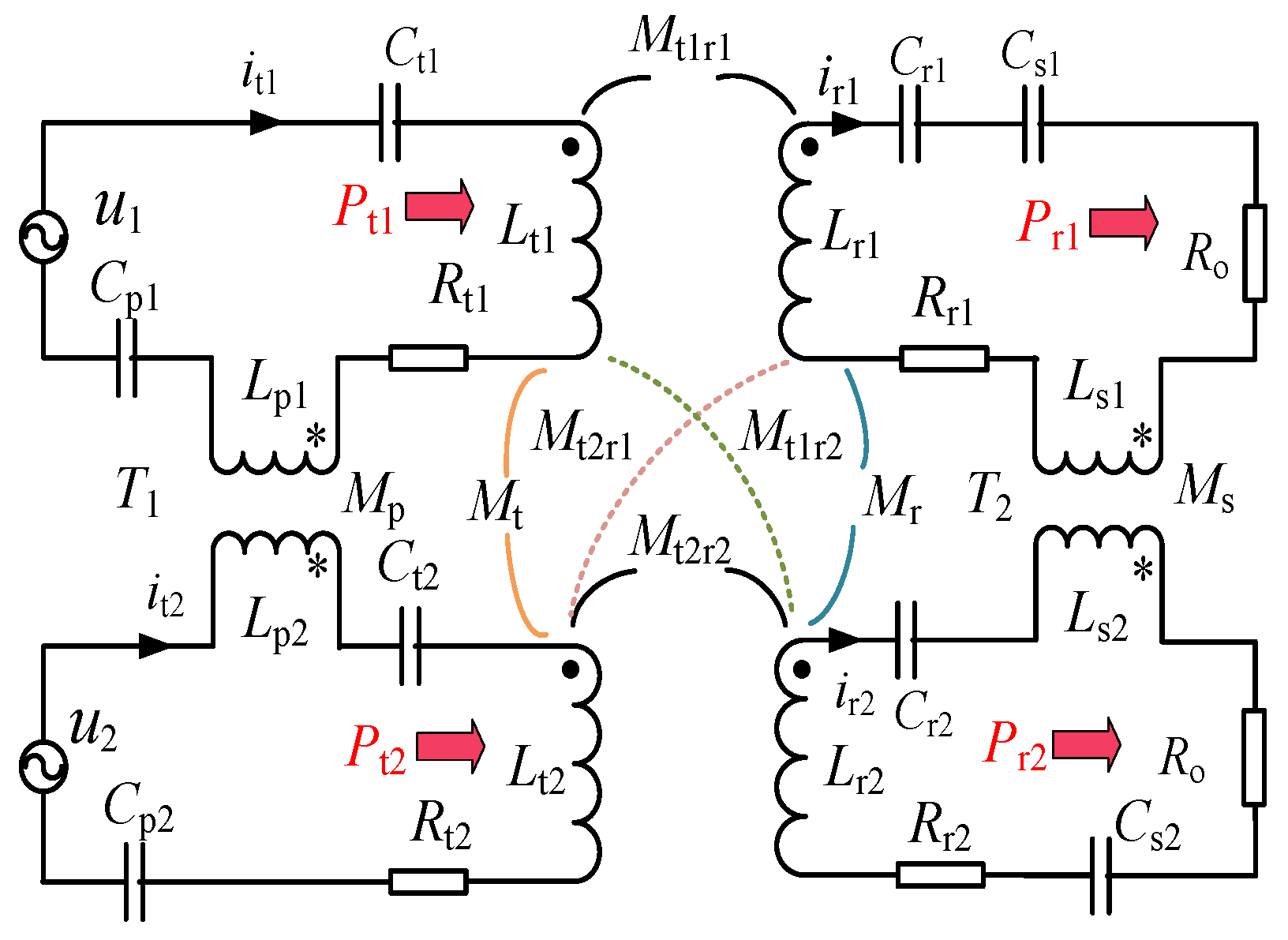





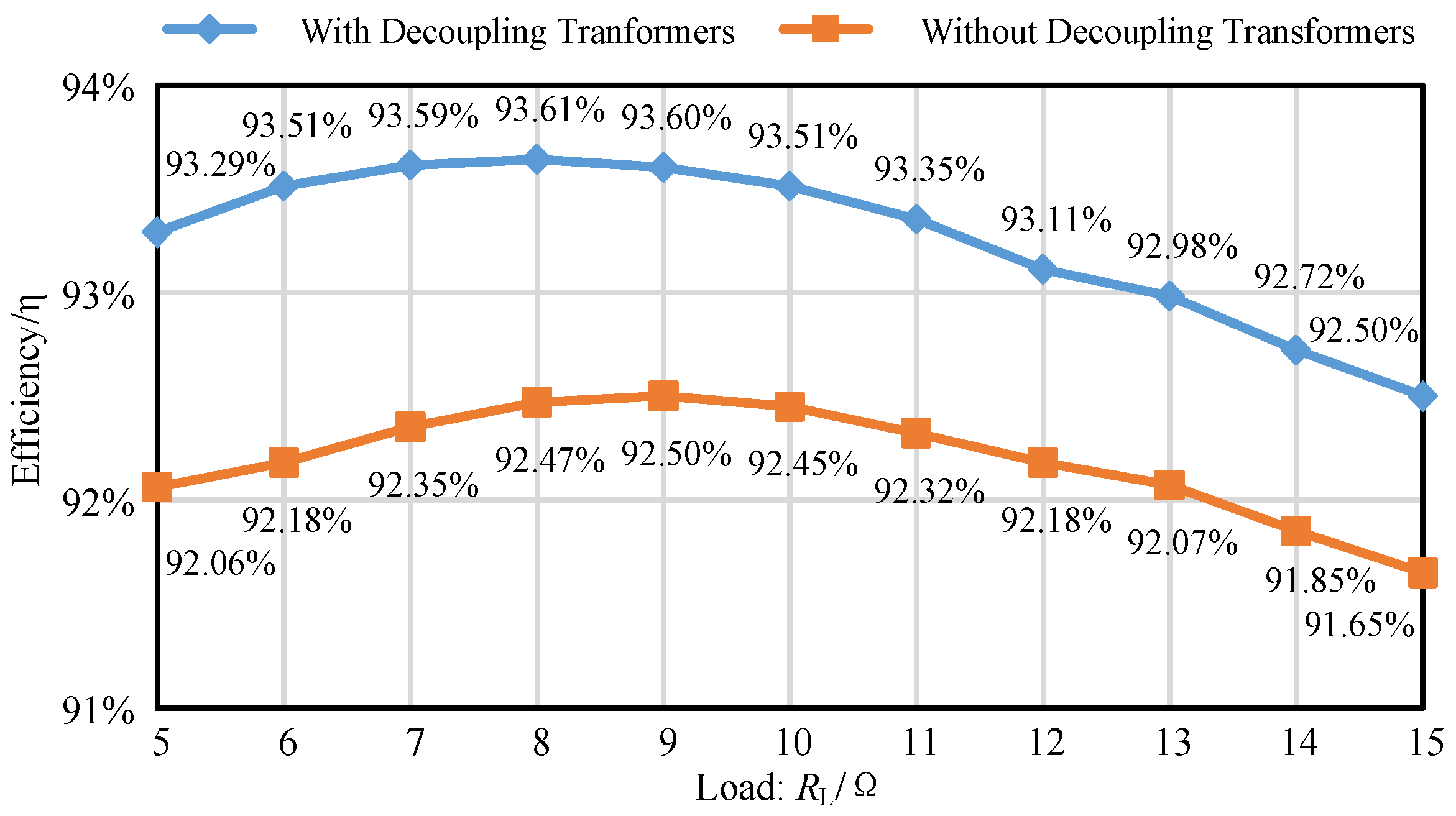

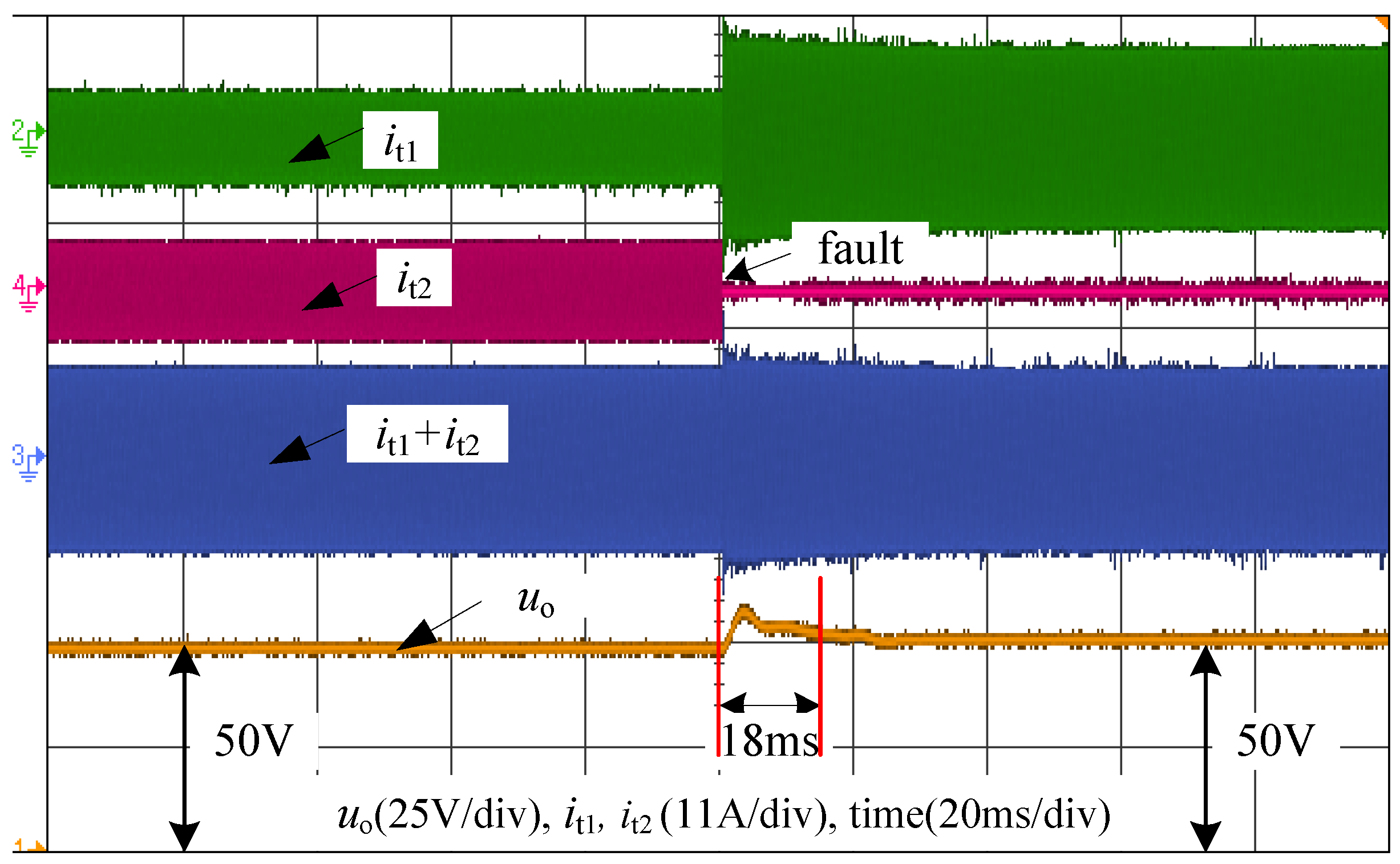
| Symbol | Value | Symbol | Value |
|---|---|---|---|
| Lt1 | 143.50 μH | Ct1 | 110.32 nF |
| Lt2 | 143.45 μH | Ct2 | 110.36 nF |
| Lr1 | 225.8 μH | Cr1 | 70.11 nF |
| Lr2 | 226.3 μH | Cr2 | 69.96 nF |
| Lp1 | 182.22 μH | Cp1 | 86.88 nF |
| Lp2 | 183.42 μH | Cp2 | 86.31 nF |
| Ls1 | 60.23 μH | Cs1 | 262.84 nF |
| Ls2 | 60.75 μH | Cs2 | 260.60 nF |
| Mt | 136.5 μH | Mp | 136.6 μH |
| Mr | 15.9 μH | Ms | 15.9 μH |
| Rt | 0.12 Ω | Rr | 0.09 Ω |
| M | 26.3 μH | - | - |
© 2017 by the authors. Licensee MDPI, Basel, Switzerland. This article is an open access article distributed under the terms and conditions of the Creative Commons Attribution (CC BY) license ( http://creativecommons.org/licenses/by/4.0/).
Share and Cite
Li, Y.; Mai, R.; Lin, T.; Sun, H.; He, Z. A Novel WPT System Based on Dual Transmitters and Dual Receivers for High Power Applications: Analysis, Design and Implementation. Energies 2017, 10, 174. https://doi.org/10.3390/en10020174
Li Y, Mai R, Lin T, Sun H, He Z. A Novel WPT System Based on Dual Transmitters and Dual Receivers for High Power Applications: Analysis, Design and Implementation. Energies. 2017; 10(2):174. https://doi.org/10.3390/en10020174
Chicago/Turabian StyleLi, Yong, Ruikun Mai, Tianren Lin, Hongjian Sun, and Zhengyou He. 2017. "A Novel WPT System Based on Dual Transmitters and Dual Receivers for High Power Applications: Analysis, Design and Implementation" Energies 10, no. 2: 174. https://doi.org/10.3390/en10020174






